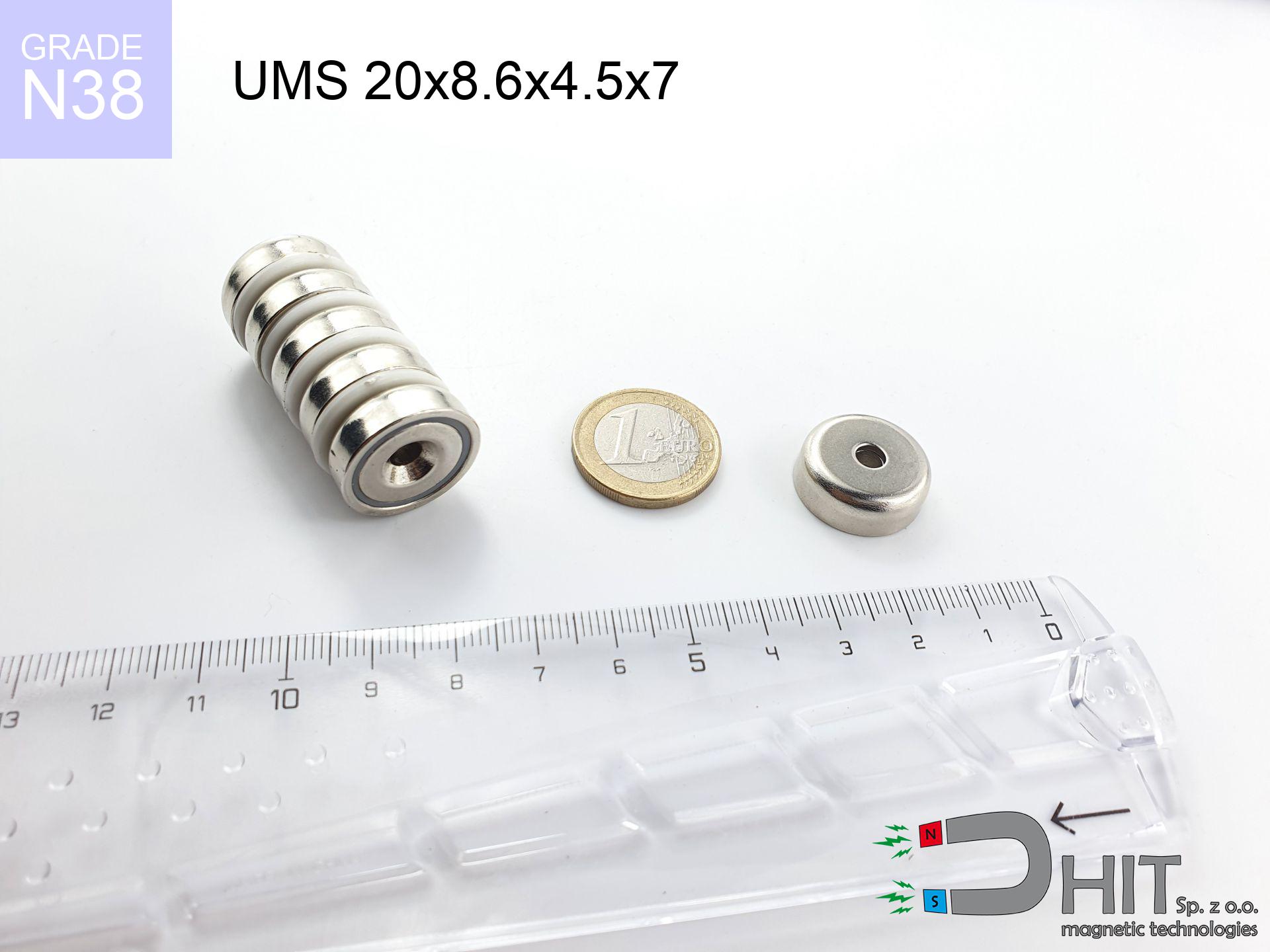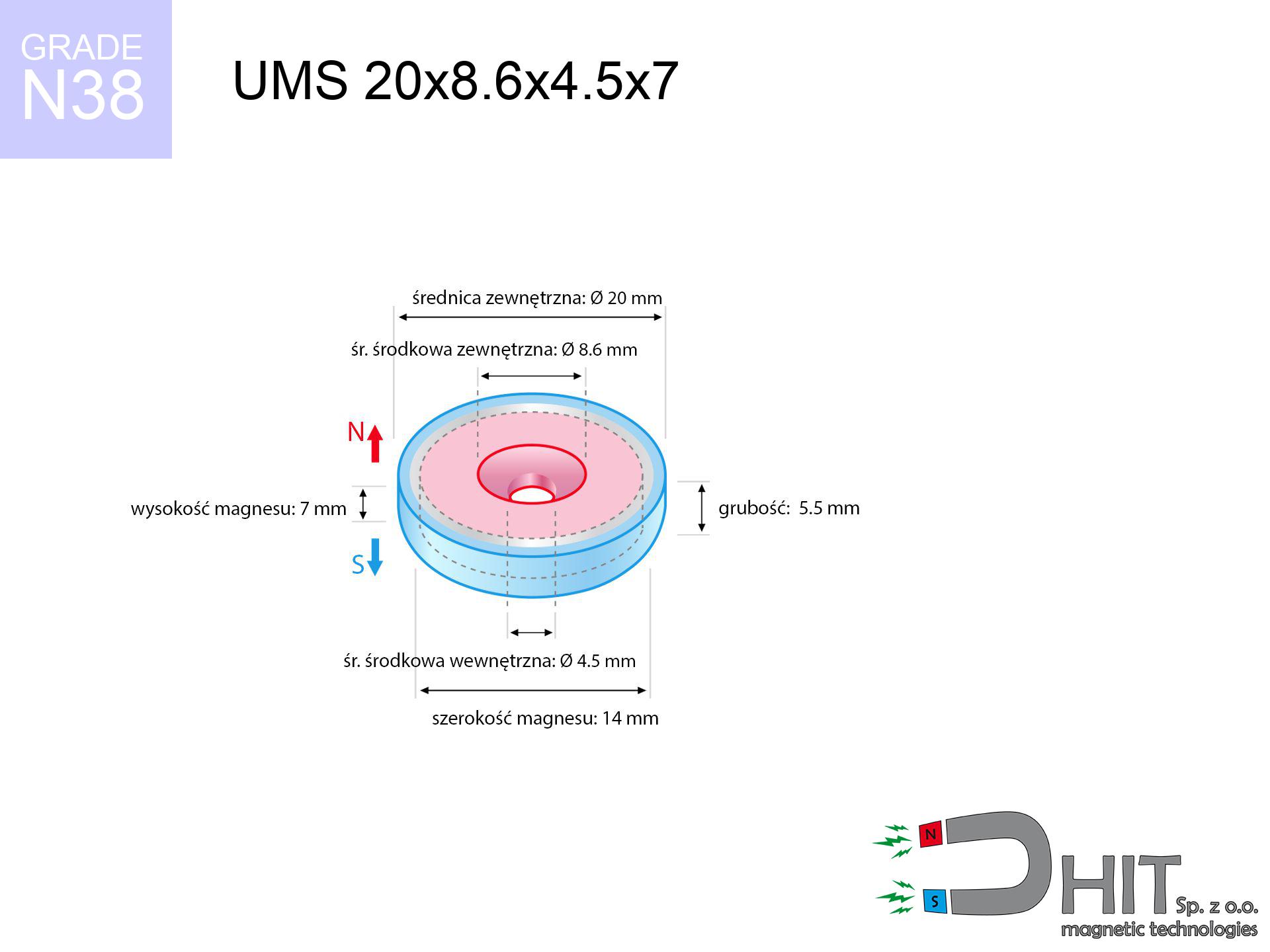UMS 20x8.6x4.5x7 / N38
conical magnetic holder
catalog number 220327
GTIN: 5906301814177
diameter Ø
20
mm [±0,1 mm]
cone dimension Ø
8.6x4.5
mm [±0,1 mm]
height
7
mm [±0,1 mm]
magnetizing direction
↑ axial
capacity ~
6.00 kg / 58.84 N
max. temperature
≤ 80
°C
catalog number 220327
GTIN: 5906301814177
diameter Ø
20 mm [±0,1 mm]
cone dimension Ø
8.6x4.5 mm [±0,1 mm]
height
7 mm [±0,1 mm]
magnetizing direction
↑ axial
capacity ~
6.00 kg / 58.84 N
max. temperature
≤ 80 °C
6.46 ZŁ gross price (including VAT) / pcs +
5.25 ZŁ net price + 23% VAT / pcs
bulk discounts:
need more quantity?Want a better price?
Give us a call tel: +48 22 499 98 98 or contact us via form on our website. You can check the power and the appearance of neodymium magnet in our magnetic mass calculator magnetic calculator
Orders placed by 2:00 PM will be shipped on the same business day.
Specification: conical magnetic holder 20x8.6x4.5x7 / N38 ↑ axial
Magnetic properties of the material N38
Physical properties of sintered neodymium magnets Nd2Fe14B
Product suggestions
Advantages as well as disadvantages of neodymium magnets NdFeB.
In addition to immense power, neodymium magnets have the following advantages:
- They do not lose strength over time. After about 10 years, their power decreases by only ~1% (theoretically),
- They are highly resistant to demagnetization by external magnetic sources,
- In other words, thanks to the glossy nickel, gold, or silver finish, the element gains an visually attractive appearance,
- They exhibit very high magnetic induction on the surface of the magnet,
- Magnetic neodymium magnets are characterized by very high magnetic induction on the surface of the magnet and can operate (depending on the shape) even at temperatures of 230°C or higher...
- Thanks to the flexibility in shaping or the ability to adapt to specific requirements – neodymium magnets can be produced in many variants of shapes and sizes, which amplifies their universality in usage.
- Key role in modern technologies – are utilized in HDD drives, electric drive mechanisms, medical apparatus or various technologically advanced devices.
Disadvantages of neodymium magnets:
- They can break as they are extremely fragile when subjected to a powerful impact. If the magnets are exposed to impacts, it is suggested using magnets in a metal holder. The steel housing in the form of a holder protects the magnet from impacts and also increases its overall strength,
- High temperatures can reduce the strength of neodymium magnets. Typically, after heating above 80°C, most of them experience a permanent reduction in strength (although it is dependent on the shape and size). To prevent this, we offer special magnets marked with the symbol [AH], which are highly resistant to high temperatures. They can operate even at temperatures up to 230°C, making them an ideal solution for applications requiring high-temperature operation,
- Magnets exposed to a humid environment can corrode. Therefore, when using them outdoors, we suggest using waterproof magnets made of rubber, plastic, or other moisture-resistant materials,
- Limited ability to create threads or complex shapes in the magnet - the use of a housing is recommended - magnetic holder
- Potential hazard to health from tiny fragments of magnets can be dangerous, in case of ingestion, which is crucial in the context of child safety. Additionally, tiny parts of these products have the potential to complicate diagnosis in case of swallowing.
Safety Precautions
It is crucial not to allow the magnets to pinch together uncontrollably or place your fingers in their path as they attract to each other.
In the case of placing a finger in the path of a neodymium magnet, in such a case, a cut or a fracture may occur.
Maintain neodymium magnets away from children.
Remember that neodymium magnets are not toys. Be cautious and make sure no child plays with them. In the case of swallowing multiple magnets simultaneously, they can attract to each other through the intestinal walls. In the worst case scenario, this can lead to death.
Under no circumstances should neodymium magnets be brought close to GPS and smartphones.
Intense magnetic fields generated by neodymium magnets interfere with compasses and magnetometers used in navigation, as well as internal compasses of smartphones and GPS devices.
Neodymium magnets can become demagnetized at high temperatures.
Although magnets have shown to retain their effectiveness up to 80°C or 175°F, this temperature may vary depending on the type of material, shape, and intended use of the magnet.
Neodymium magnets are among the strongest magnets on Earth. The surprising force they generate between each other can surprise you.
To handle magnets properly, it is best to familiarize yourself with our information beforehand. This will help you avoid significant harm to your body and the magnets themselves.
Neodymium magnetic are highly susceptible to damage, leading to their cracking.
Magnets made of neodymium are fragile and will break if allowed to collide with each other, even from a distance of a few centimeters. Despite being made of metal as well as coated with a shiny nickel plating, they are not as hard as steel. In the case of a collision between two magnets, there can be a scattering of small sharp metal fragments in different directions. Protecting your eyes is essential.
The magnet coating is made of nickel, so be cautious if you have an allergy.
Studies show a small percentage of people have allergies to certain metals, including nickel. An allergic reaction often manifests as skin redness and rash. If you have a nickel allergy, try wearing gloves or avoid direct contact with nickel-plated neodymium magnets.
Neodymium magnets are not recommended for people with pacemakers.
Neodymium magnets produce strong magnetic fields that can interfere with the operation of a heart pacemaker. However, if the magnetic field does not affect the device, it can damage its components or deactivate the device when it is in a magnetic field.
Dust and powder from neodymium magnets are flammable.
Avoid drilling or mechanical processing of neodymium magnets. If the magnet is crushed into fine powder or dust, it becomes highly flammable.
Keep neodymium magnets away from TV, wallet, and computer HDD.
Magnetic fields generated by neodymium magnets can damage magnetic storage media such as floppy disks, credit cards, magnetic ID cards, cassette tapes, video tapes, or other similar devices. In addition, they can damage televisions, VCRs, computer monitors, and CRT displays. You should especially avoid placing neodymium magnets near electronic devices.
Please read the article - What danger lies in neodymium magnets? You will learn how to handle them properly.




![magnetic separator 25x300 [2xM8] / N52 magnetic separator 25x300 [2xM8] / N52](https://cdn3.dhit.pl/graphics/products/sm-25x300-2xm8-dij.jpg)
![search holder 135x40 [M10+M12] GW F 600 kg / N38 search holder 135x40 [M10+M12] GW F 600 kg / N38](https://cdn3.dhit.pl/graphics/products/ump135x40-m10+m12-gw-f-600-kg-luz.jpg)


